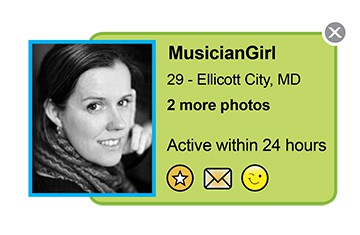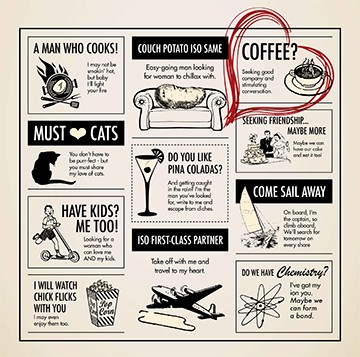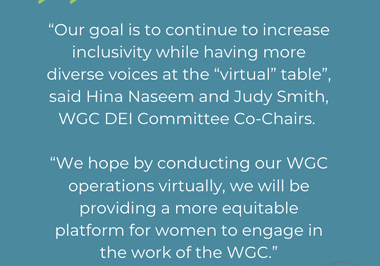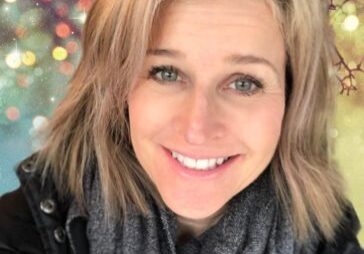VISITING A DATING SITE MIGHT BE THE FIRST STEP IN GETTING BACK IN THE GAME
Story By Elizabeth Brunetti
Madeline Adkins was nearly 30 before she started dating. She’d had two long-term relationships in her 20s, but had never thrown herself into the dating scene.
The associate concertmaster of the Baltimore Symphony Orchestra, Adkins, who lives in Ellicott City, found herself spending much of her free time with fellow musicians. “We tend to only hang out with one another,” she says. “I was ready to meet a ‘civilian’ – that is, a nonmusician.” Even so, it wasn’t as easy as  she had anticipated. “It was difficult to meet quality new people. The bar scene is not so great for finding relationships, and I had tried a lot of other things, but I wasn’t getting the volume of people to choose from,” she says.
she had anticipated. “It was difficult to meet quality new people. The bar scene is not so great for finding relationships, and I had tried a lot of other things, but I wasn’t getting the volume of people to choose from,” she says.
“I did anything to find a date,” says Martha Townsend, 34, a physician’s assistant from Catonsville. “Speed dating, joined a running club, asked friends to hook me up, frequented the grocery store, went out to bars …” She was asked out by a man she met at the grocery store once, she says, but for the most part, her date-seeking efforts didn’t pan out.
Indeed, navigating the dating world can be overwhelming and frustrating. For women who have been through a divorce, it can be even worse. “After a relationship you thought would last forever ends, it’s hard to get excited about starting over,” says Susan Treusdell, a computer programmer from Ellicott City who, several years ago, found herself divorced with a 2-year-old daughter. “I felt betrayed, so it was hard to imagine being able to trust again.”
Whether you’re recovering from a divorce or just entering the relationship world, breaking into the dating scene can seem daunting. Linda Gordon, a clinical social worker who has worked extensively with divorced women, compares dating – with all the searching, scheduling, primping and prepping – to a part-time job. And if you’re coming out of a divorce, she says, it’s important to be extra careful. Before stepping into the dating world, she recommends, “you need some time for healing.” For Treusdell, it took several years for her to feel confident enough to date again, and several more years of dating before she eventually remarried in 2003.
In 2007, both Adkins and Townsend turned to online dating to help them seek partners. “I primarily used Match.com,” says Adkins, now 36. “I wanted to use the volume of users to get to know a lot of people at once and to keep it casual until I knew I was sure I wanted to pursue a relationship with someone.”
Townsend, who had dubbed 2007 the “Year of Martha,” also joined the dating site. “I liked Match.com because it gave me more freedom to search profiles. I had more power over who I dated because I could search on my own terms and pick my matches.” Townsend believes that seeking a mate online compares favorably to meeting someone randomly. “It lets you see more into someone’s world than meeting in a bar or on a sports league.” Townsend ended up going on dates with three men. “The first two didn’t get second dates. The third I ended up marrying.”
 Adkins spent a bit more time looking for her match. She committed to six months, spending about an hour a day browsing profiles and writing emails. Though it took a lot of time, she says she enjoyed perusing profiles. “I actually met a number of good guys online,” she reports. “Out of the 20 or so I met in person, I’d say half were relationship material – just not for me.”
Adkins spent a bit more time looking for her match. She committed to six months, spending about an hour a day browsing profiles and writing emails. Though it took a lot of time, she says she enjoyed perusing profiles. “I actually met a number of good guys online,” she reports. “Out of the 20 or so I met in person, I’d say half were relationship material – just not for me.”
Adkins’ six-month online odyssey wasn’t entirely smooth sailing, though. When discussing their hesitations about online dating, many women cite stories about awkward encounters with people met online. Adkins experienced a few of these. “There was one guy who wanted to take my leftovers home to his mother,” she remembers. “Another one insisted on calling me a nickname long after I’d told him I hated it.”
Just when she was about to take a break from online dating, Adkins got a thoughtful email from a man named John. “He lived only a few miles from me,” she says. “He took me on a hot air balloon ride for our first date.” Adkins found that she and John had a lot in common and had fun together; the two bonded in particular over a love of travel. “We planned our first international trip together after only several months of dating, and we haven’t stopped since,” she says. “He proposed during a trip to the Galapagos Islands.” The two were married in 2010, after three and a half years together. They paid homage to their digital beginnings by displaying an oversized poster of their original online dating profiles at their wedding.
Adkins’ and Townsend’s stories both have the happy ending that most women hope for when they first click “Join” on a dating site. In a world increasingly devoted to social media and technology, online dating services are more popular than ever – a combined 35 million people subscribed to eHarmony and Match.com last year, helping the online dating industry rake in a little more than $1 billion in revenue. Even home and style diva Martha Stewart has entered the world of online dating, meeting two potential Match.com suitors on the “Today Show” last May.
While the large pool of singles on sites like Match.com may appear to make finding dates easy, says Gordon, women outnumber men two-to-one in the region. “There just aren’t as many men out there.” At age 26, women have more online pursuers than men; but by the age of 48, the flow shifts to the point where men have twice as many pursuers online. These numbers may lead you to believe it’s nearly impossible to find a mate, especially later in life. However, women who have used online sites say that by logging on, you increase the chances of finding someone who shares your interests and is looking for the kind of relationship you want. The stigma of online dating, says Gordon, has changed dramatically in the last 20 years. “It’s very common,” she points out. “In some ways, it’s the new norm.”
Even so, some women choose to go a step further and enlist the services of a professional matchmaker. Michelle Jacoby is owner of DC Matchmaking, a small boutique (and expensive) service that combines matchmaking and life coaching. She includes online dating in the mix when she’s helping her clients find a partner, but also goes the extra mile. “I interview friends and relatives to get their input about why this person may be having trouble finding love,” she says. That, along with a sevenpage questionnaire, helps Jacoby devise an individualized dating plan specific to each client’s needs. Jacoby is quick to emphasize the role that life coaching can play in matchmaking services, ranging from “image consulting” – also known as a makeover – to lengthy conversations about attitude, uncovering what a client really wants and how to identify healthy partners. While this approach is much more costly, clients have the benefit of a completely personalized approach to finding a partner. Despite the cost (Jacoby is reluctant to disclose actual fees, though says it’s “in the thousands”), DC Matchmaking currently has a threemonth waiting period for potential clients interested in coaching; in fact, there is such a demand for her services Jacoby has started developing a group coaching method to reach more clients at a lower price.
One of Jacoby’s main missions in matchmaking, she says, is to find matches that “complement rather than complete” her clients. “It takes a lot of time and energy to build balance and happiness as a single woman,” she says. “One wrong relationship and everything’s out of balance again, and you have to start over.” She advises her clients to build a life in which they are content before trying to find a partner. “Everyone should have the chance to stand on their own two feet,” she says. “Finding your own way is a really powerful thing – and then you find love.”
Linda Gordon agrees. To find a healthy relationship, she says, a woman must first be healthy herself: “Become the person you want to love; take care of yourself.” Instead of entering the dating world on a headlong quest to find “The One,” these experts instead recommend that women first build up their own lives. “Here’s what I want to hear from a client,” says Jacoby. “I want to hear ‘I have a great life. I love my job, I love where I live, I am complete. I’d just like to find someone to spend my life with.’ ”
Gordon advises her clients along the same lines. “Make the life you want to live. If you find someone, it’s icing on the cake; and even if you don’t, you still have the cake.” *




